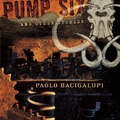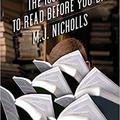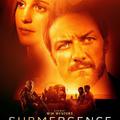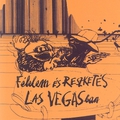Mark Z. Danielewski: House of Leaves

Recently I came across the title of this novel in several different places all over the web, and in these cases, though I’m not a particularly mystical person believing in signs, I tend to think that perhaps these coincidences happen for a reason, and I should take a closer look at the book in question. This I promptly did. I checked what this novel was about, became enthusiastic and ordered it almost immediately. As this is a very complex novel both in terms of content and structure, this blog entry will be rather long and will contain spoilers.
House of Leaves is a multi-layered novel. The narrator of the outer story is Johnny Truant, an apprentice to a tattoo artist, living in Los Angeles. When he’s not working, he spends his time doing drugs and chasing women with his friend Lude. In Lude’s apartment building lives a mysterious old man called Zampanò who dies one day and leaves behind a huge trunk full of papers. The trunk somehow ends up at Johnny’s place, and initially Johnny disregards its contents. Soon, however, he starts to read parts of the text written on the pieces of papers, and it’s not long before he begins to realize the connections among the bits and pieces. From here it’s only a short step for Johnny to become completely obsessed with Zampanò’s text, and he ends up compiling the material and creating the novel titled The Navidson Record. He also adds his own, highly personal notes to those written by Zampanò himself, and completes the book with the story of his own obsession with the novel.
To make matters even more complicated, The Navidson Record itself is not a regular, linear, story-telling kind of book either. The Navidson Record tells the story of Pulitzer-prize winning photojournalist, Will Navidson who moves with his family to a nice old house somewhere in the Virginia countryside, but soon it turns out that their cozy new home is in fact an immense, constantly changing, uniformly dark and cold labyrinth. Navidson, a man never shying away from dangerous situations, is intrigued, and organizes several expeditions to find out more about the labyrinth of his house. The events of these expeditions are covered by ample video footage, the characters themselves keep their own video journals, and photos are also taken of everything important. All these videos and photos are then organized and edited to form a movie called The Navidson Record. And the novel called The Navidson Record is as much about the story of the Navidson family as about the making of the movie and about the way the movie was received and interpreted by different audiences.
I wrote about Pynchon’s Gravity’s Rainbow earlier this year (this post is not available in English yet) that it was the first book I’ve ever read which wasn’t only telling a story about something, but in a way became the same as its material, the reality it depicted. Now I’ve come across another such novel: House of Leaves. And in a sense this novel goes even further than Gravity’s Rainbow. Because apart from the fact that the novel itself is like a labyrinth (or more precisely: it’s not like a labyrinth, it is a labyrinth), it steps out of itself and literally eats itself into the reader’s mind, knows in advance every thought every thought of the reader, and includes all possible reactions to the novel, and every possible interpretation a reader might come up with.
A single example would suffice here. One chapter deals extensively with different labyrinths and with the architectural characteristics (or rather the lack of any distinct characteristics) of the Navidson house. This chapter is in itself already a labyrinth. One footnote leads to another, which in turn leads to yet another, but after working yourself diligently through all the footnotes, you won’t see any clearer, as the footnotes don’t tell you about what the house is like, but about what it’s not like. It also happens that more references lead to the same footnote, and the chapter also contains parts of texts which are mirrored or in other ways distorted, so by the time I carefully digested the unbelievable amount of information contained in the footnotes, I could hardly recall where I started from. And even though the chapter isn’t particularly long, it took me almost three hours to read it, and I could hardly wait to read a more linear, more text-like text.
As it turned out, Johnny, the outer narrator (and first reader and compiler) of the story reacted to this chapter in the same way. In one of his footnotes in the next chapter, he describes the same frustration I felt, and voices the same desire to read something which doesn’t hurt the eye and the mind as much as the previous chapter. Our wish does come true: the next chapter is the exact opposite of the „labyrinth chapter”: the pages usually contain only a couple of lines of easily readable text, there are hardly any footnotes, and most of the paper is soothingly blank.
However, two things are worth mentioning. One is that what little text does appear in the otherwise blank pages is most emphatically not soothing, and considering some of the events in this chapter, the labyrinthine text of the previous one sometimes almost seems like a nice and easy read. The other, even more disturbing thing is the realization that the reader I so readily identify with and whose emotions while reading the Navidson Record I so strongly share is no other than Johnny Truant who starts out in his introduction to the book with the description of how this novel changed his life for the worse, and who suffers from increasingly serious mental disorders as he progresses with the compilation and reading of the story.
Reading House of Leaves is like doing an investigation (despite the fact that this is definitely not a detective novel). I don’t read too much crime fiction, but when I start reading a crime novel, I never strain myself too much (or at all) to come up with the solution on my own as I know that I’m not a talented investigator, so usually I just let go and let the story entertain me. House of Leaves, however, doesn’t let me lean back and feel good. It involves me and forces me to identify with the characters from the very first page, and as I’m already Johnny (and Will Navidson and Karen Green as well, for that matter) I cannot simply sit back and wait passively in the hope that perhaps the others will go ahead and solve the mysteries, I must try my best and do everything I can from the „outside” as a reader. (As if there were such a place as the outside in this novel.) Therefore I read many especially complicated passages two or three times in a row, and read even those footnotes with a relentless (manic) faith that contained nothing more than a list of several hundred architects, buildings or movies, hoping that sooner or later I will find a sign which could be a key to the whole story.
Reading House of Leaves is also similar to reading a detective novel in the sense that the novel is full of signs which entice me to follow them; moreover, the novel constantly forces me into making uncomfortable decisions, and it never turns out whether I made the right decisions. For instance, somewhere towards the beginning of the novel, in a footnote about one of Johnny’s footnote the (entirely fictional) editors give us a piece of advice, saying that if the reader wishes to follow their own instincts she can go ahead with reading the main story, however, if she feels that knowing more about Johnny’s background might help her in the interpretation of the story, then she can jump ahead to the appendix and read a collection of letters Johnny received from his institutionalized mother. I turned to the appendix but when I say that the letters take up 60 pages, I decided to leave them to the end, partly because I wanted to follow my instincts, and partly because I was more interested in Navidson’s story than in Johnny’s (as I am Johnny, the reader, so I surely know enough about myself – at least this is what I thought).
In the end I read the letters in the appendix of course, but now I have no way of knowing in what ways my reading experience would have been different, had I read them at the time when the footnote I mentioned directed me to them. One thing is certain: if I had read the letters then (in time?), I would have received an explanation for a sign appearing only once in the novel, a sign I noticed but couldn’t interpret without knowing the contents of the letters. If I had known then, before reaching the 100th page of the novel what this particular sign (might have) stood for, I’m sure I would have reached very different conclusions as to the whole novel in general, and the identity of the characters in particular. But, again, there’s no way of knowing which of these would have been the „correct” reading method, and I tend to think there would have been no single correct method at all. As Johnny writes in the Introduction:
See, the irony is it makes no difference that the documentary at the heart of this book is fiction. Zampanò knew from the get go that what's real or isn't real doesn't matter here. The consequences are the same.I can suddenly imagine the cracked voice I never heard. Lips barely creasing into a smile. Eyes pinned on darkness:„Irony? Irony can never be more than our personal Maginot Line; the drawing of it, for the part, purely arbitrary.”(Pantheon Books, New York, 2000, p. xx)
And indeed. It wouldn’t have made any difference if, being aware of the contents of the letters, I had interpreted several parts of the novel differently, or if I had taken the whole novel to be ironic, as I’m sure that House of Leaves still would have made a huge impression on me, since for a novel to have effect it doesn’t matter at all whether something in the book is real or (doubly) fictional, or whether something is to be taken literally or ironically.
By the way, if you happen to have the impression that House of Leaves is not an easy read, you are right. Following the multiply embedded storylines, the footnotes which sometimes meander through several pages, and the visual and typographical oddities is at times not at all easy, in fact, reading this book is often a truly frustrating task which requires considerable effort on the reader’s part. On the other hand, however, House of Leaves is such a fascinating read, engaging my attention from the very first page, and never letting it go until the very end, that I didn’t for a moment regret all the time and energy I needed to invest into this novel.
(Now I paused for a second and tried to decide whether my last two lines were contradictory or not, and I came to the conlusion that they weren’t. Why couldn’t a novel be difficult to read and fascinating, frustrating and stunning at the same time? Why couldn’t it force me to face myself and my own reality, and at the same time make me forget myself and enable me to get truly lost in a fictional world? House of Leaves is such a novel.)
But House of Leaves isn’t just a terrific, cleverly constructed novel which makes utmost use of such postmodern literary techniques as fragmenting the story and jumbling the chronology of events. It is a beautifully written, unspeakably heartbreaking and unsettling book as well. I don’t know if I make you more curious about the book, or if I totally discourage you with this, but House of Leaves was the first book this year which didn’t simply brought me close to tears, but could actually make me cry. More than once.
Which is all the more surprising for me as it rarely (virtually never) happens that a novel in which the form, the structure and the way the story is told are as important as the story itself can induce such emotions in me. I love postmodern literature, and I can get really enthusiastic about a clever, stylistically, structurally or narratologically unique novel, and basically ignore the story itself, but this is simply not the kind of literature that could break my heart. House of Leaves is as clever and postmodern as it comes – and still manages to break my heart. This is the kind of book it is. It resolves all, seemingly inherent contradictions; it withstands all easy, ready-made interpretations; and it proves on its own example that two, apparently mutually exclusive characteristics can be equally true at the same time.





